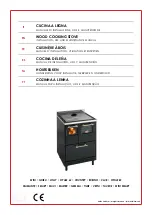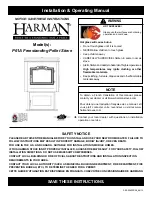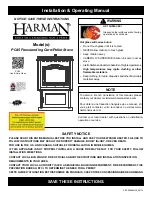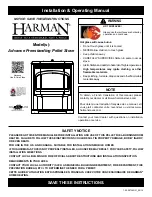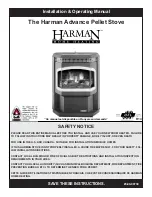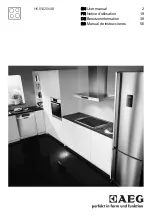
28
29
Maintenance of the Sauna Stove
The manufacturer suggests that the
maintenance of the sauna stove is
carried out by qualified professionals.
Soot accumulating in the flues of the
sauna stove is removed from all the
sides of the fireplace through circu
-
lar cleanout holes. The outlet for the
flue gases and the chimney must be
cleaned regularly; it is also required to
check the operating state if the de-
vice has not been not in use for a long
period of time.
When in use, stones are gradually
wearing off, that is why they must be
replaced at least once a year (more
often in the case of heavy use). Stone
waste accumulating in the lower part
of the sauna stove must be removed,
whereas damaged stones, replaced.
To ensure air draft, the chimney must
be cleaned regularly.
The ash pan is cleaned every time
before the sauna stove is burned to
ensure passage of combustion air
through the ash pan to the bench-
es. To remove ash, metal utensils are
used, preferably with legs. The user of
the sauna stove requires at least 1 m²
of space in front of the oven door.
!!! Removed ash may contain glowing
particles; it is thus prohibited to hold
utensils used for removing ash near
flammable materials.
The water jacket of the steam stove
should be cleaned occasionally; the
frequency of cleaning depends on
the quality of water, the size of the
benches, and the water heater as
well as the model of the sauna stove.
Normally, the average maintenance
period is once a year; in the case of
failure, maintenance must be per
-
formed immediately.
Serwisowanie pieca do sauny
Producent zaleca zlecanie serwiso
-
wania pieca do saun wykwalifikowa
-
nym specjalistom.
Sadza zbierająca się w przewodach
pieca do sauny jest usuwana ze
wszystkich ścianek paleniska poprzez
okrągłe otwory wyczystkowe. Wylot
przeznaczony dla spalin oraz komin
muszą być czyszczone regularnie. Je
-
żeli urządzenie nie było używane przez
dłuższy czas, wymagane jest również
sprawdzanie stanu roboczego,.
Kamienie ulegają stopniowemu zuży
-
ciu, dlatego też muszą być wymienia
-
ne przynajmniej raz w roku (częściej w
przypadku intensywnego użytkowa
-
nia). Odpady z kamieni, które aku
-
mulują się w dolnej części pieca do
sauny, muszą być usuwane, natomiast
zniszczone kamienie wymieniane. Aby
zapewnić ciąg powietrza, komin musi
być czyszczony regularnie.
Popielnik czyści się przed każdym roz
-
paleniem pieca, aby zapewnić prze
-
pływ powietrza spalania do ławek. W
celu usunięcia popiołu, stosuje się me
-
talowe naczynia, najlepiej z nóżkami.
Użytkownikowi pieca do sauny należy
zapewnić przynajmniej 1 m² przestrze
-
ni od drzwiczek pieca.
Usuwany popiół może zawierać żarzą
-
ce się cząstki. Zabronione jest zatem
przechowywanie naczyń stosowa
-
nych do usuwania popiołu w pobliżu
materiałów łatwopalnych.
Płaszcz wodny pieca parowego po
-
winien być czyszczony co jakiś czas.
Częstość czyszczenia zależy od ja
-
kości wody, rozmiaru ławek oraz po
-
jemności podgrzewacza do wody,
jak również modelu pieca. Zazwyczaj
konserwację wykonuje się raz do roku.
W przypadku awarii, naprawa musi
być przeprowadzona niezwłocznie.
Stones for the Fireplace
!!! In the case of P-series models, stones
for the fireplace must not impede the
air flow between the fireplace and
the frame.
!!! In the case of S-series models,
stones placed on the sides must not
bring pressure on the wire mesh and
the content. They must be positioned
so as to have a sufficient air gap and
not bring pressure on the wall of the
fireplace.
!!! Some natural stones contain im
-
proper contaminants, e.g., sulphur;
thus, such stones are not suitable for
use.
Before placing stones into the fire
-
place, clean dust off them. Large
stones are placed on the bottom,
and smooth stones, on the sides. Small
stones are placed on top as they are
heated quickly. Steam humidity de
-
pends on the number of stones and
the temperature in the steam room.
The higher the number of stones and
the lower the temperature, the more
humid the steam.
Połączenie pieca do sauny do wbu
-
dowanego komina
!W przypadku modeli pieców serii P,
kamienie przeznaczone do paleniska
nie mogą utrudniać przepływu po
-
wietrza pomiędzy paleniskiem a jego
ramą.
W przypadku modeli serii S, kamienie
ułożone po obu stronach, nie mogą
wywierać nacisku na siatkę oraz na
zawartość pieca. Muszą one być uło
-
żone w taki sposób, aby powstała
szczelina powietrzna, a nacisk nie był
wywierany na ścianki paleniska.
Niektóre naturalne kamienie zawiera
-
ją nieodpowiednie zanieczyszczenia,
np. siarkę. Nie wolno stosować takich
kamieni.
Zanim kamienie zostaną ułożone w
palenisku, należy usunąć z nich kurz.
Większe kamienie należy ułożyć na
dnie, a gładkie - po bokach. Małe
kamienie są układane na wierzchu,
ponieważ najszybciej się nagrzewają.
Wilgotność pary zależy od ilości kamie
-
ni oraz temperatury w pomieszczeniu
parowym. Im większa ilość kamieni i
im mniejsza temperatura, tym bardziej
wilgotna staje się para wodna.

















